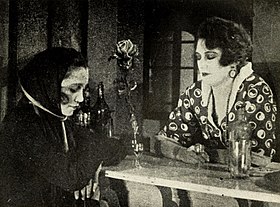Fièvre
| Movie | |
|---|---|
| Original title | Fièvre |
| Country of production | France |
| original language | French |
| Publishing year | 1921 |
| length | 44 minutes |
| Rod | |
| Director | Louis Delluc |
| script | Louis Delluc |
| production | Alhambra Films, Jupiter Films |
| camera |
Alphonse Gibory Georges Lucas |
| occupation | |
| |
Fièvre (in German fever ) is a French silent film from 1921 directed by Louis Delluc .
action
The focus of the action is a harbor bar in Marseille that the landlord Topinelli runs. He is married to Sarah, who likes to flirt extensively with men, preferably sailors, who come here. This time she is joking with a rather unattractive office worker, while the street whore Patience gets drunk in a corner and waits for a customer, "her" sailor. Sarah also thinks longingly of a sailor. It's called Militis and once went on a long journey east. She only feels contempt and disgust for her husband. When Militis returned to Marseille, he brought an oriental woman with him whom he married. He promptly stops at Topinellis Bar. Things are set in rapid motion, at the end of which there is a catastrophe.
Militis recognizes Sarah and wants to dance with her. The unsightly office worker draws Topinelli's attention to this, whereupon jealousy rises in the bar operator. Sarah doesn't mind dancing with Militis, but her husband does. He becomes jealous because he immediately realizes that something is going on between his wife and the returning sailor. When the Oriental sees a pretty flower at the bar that she would like to have and a man in a gray hat tries to infect her with it, Topinelli also becomes jealous. Suddenly Topinelli and Militis clash. and there is a violent argument. While the two fight, the third jealous woman in the group, Sarah, incites the bar whores against the Oriental. Militis dies in the extensive brawl. The police arrive and find a battlefield. Sarah sits mourning next to her dead lover, and the Oriental drops the pretty flower carelessly because it is only made of plastic.
Production notes
Fièvre - the eponymous fever is supposed to indicate the general, erotically heated mood of the protagonists - was Delluc's best-known film and opened in France on September 24, 1921. A German performance cannot be made out.
The film should actually be called "La boue" (dirt, dirt, morass). However, this title was not approved by the film censors.
Delluc had initially processed this material into a play.
The well-known painter and designer Francis Jourdain created the film structures together with Robert-Jules Garnier .
reception
“In 'Fièvre' human types are soberly characterized and the poetry of the port comes to life. Delluc also used flashbacks here. "
“Here he [Delluc] tried to give French cinema truthfulness through the highest degree of authenticity, naturalism. He combined a clear narrative rhythm with a previously unfamiliar level of poetry and the inner coherence of the plot and the characters to create an atmospherically dense and cinematic aesthetic whole. In addition, with 'Fièvre' the photographic principle of depth of field was successfully used for the first time. "
“A very characteristic motive for Delluc: the injured existence, giving up all hope. The dreams and longings turn out to be artificial. At the same time, fever illustrates the desire to escape from reality. "
Web links
- Fièvre in the Internet Movie Database (English)

